
|
|

|
HELLENISTIC
Hasmonaean / Greek Era
2nd Temple Period, Maccabeean, King Jonathon
332 - 63 B.C.E.
Chanukah
Catalogue # 2004, Item # 1:
Highly Decorated Painted with Long Spout
Not restored, Good condition.
6 cm W x 9.0 cm L x 2.5 cm H
Excavated in Samaria north of Jerusalem
Acquired Feb 2004 Jerusalem
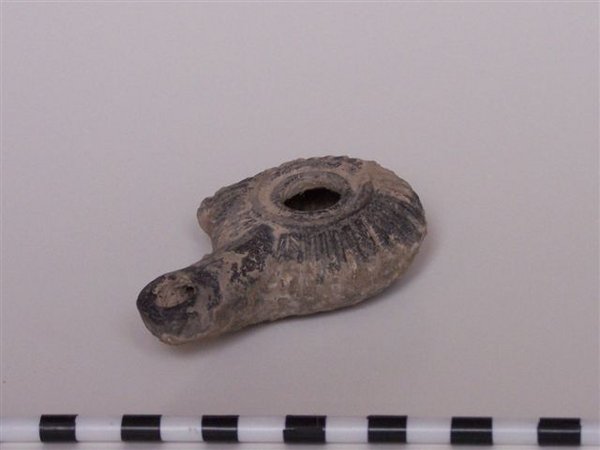
EARLY ROMAN I
Herodian / Early Roman I
2nd Temple Period, King Herod Agrippa I
63 B.C.E. - 70 C.E.
Jewish Revolt against the Romans
Catalogue # 12771, Item # 5:
Round Moulded Closed Bowl Type,
No design, no base, closed in spout with
Soot marks, details of wear, very thin walls, very fragile.
6.5 cm W x 8 cm L x 1.5 cm H
Excavated in Jerusalem
Acquired Nov. 1994 Jerusalem
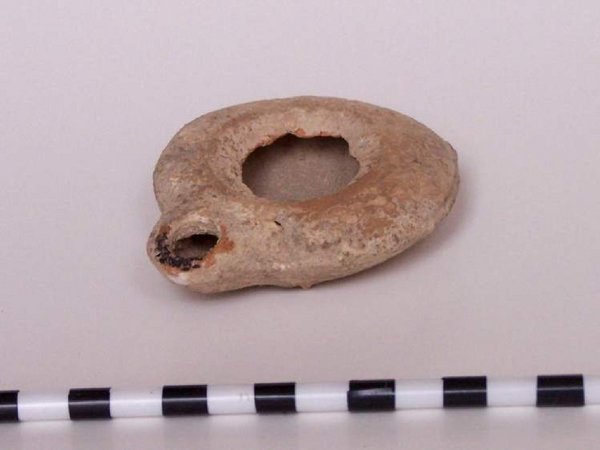
.
HELLENISTIC
Hasmonaean / Greek
2nd Temple Period
332 – 63 B.C.E.
The Greek Influence
Catalogue # 1150, Item # 6:
Closed Bowl, Heavy Walls with Deep Base,
Closed in long spout with soot marks,
Excellent condition.
5.5 cm round with 9 cm L spout,
3 cm round base x 0.5 cm H
Excavated in Jerusalem
Acquired Oct. 1997 Jerusalem
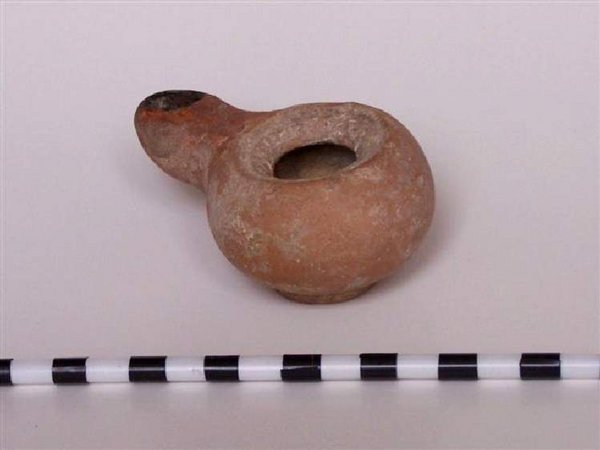
LATE ROMAN II
Symptoms of Decay
Thracia Caesari, Roman Province
70 - 324 C.E.
The Roman Influence
Catalogue # 2004-1, Item # 31:
Highly Ornate, Hero-Horseman 'Kybele' Goddess of Nature,
Red Clay with a Sculptured Arrow-Head Spout
Flat Rounded Base, good condition
5.5 cm W X 8 cm L,
Excavated in Serdica (Sofia Outskirts)
Acquired Aug 2004 Sofia, Bulgaria
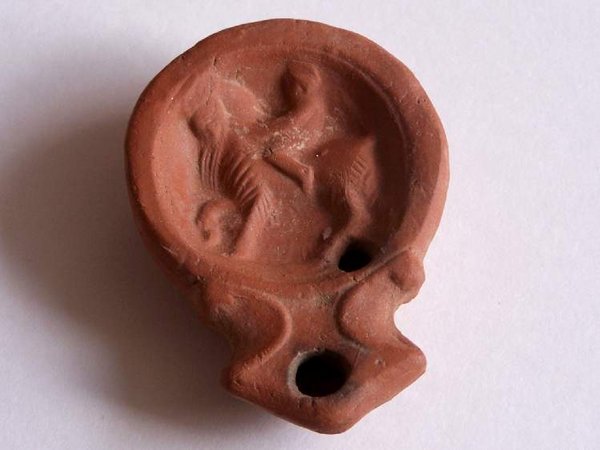
LATE ROMAN II
Symptoms of Decay
Thracia Caesari, Roman Province
70 - 324 C.E.
The Roman Influence
Catalogue # 2004-2, Item # 32:
Very Small Plain White Clay Lamp, Tiny Filling Hole, Restored
Large Wick Nozzle, Small Inched Handle
1.25 cm W X 6.5 cm L X 3.0 cm H
Excavated in Serdica (Sofia Outskirts)
Acquired Aug 2004 Sofia, Bulgaria
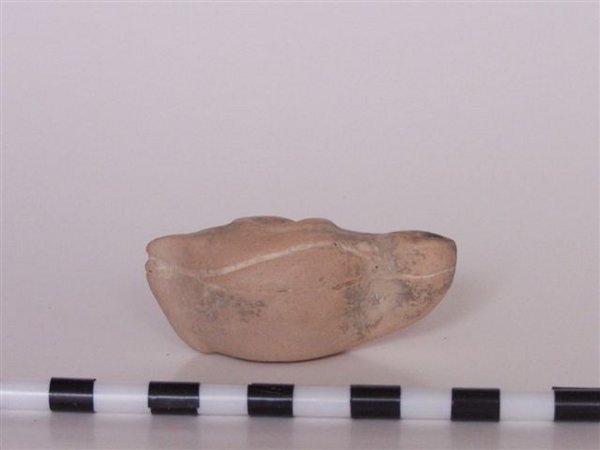
BYZANTINE
Christian / Jewish Era
New Age of Islam
324 - 640 C.E.
Development of Rabbinical Sermonic Liturgy
Catalogue # 811, Item # 11:
Triangular Closed Moulded Type
Richly decorated with a Menorah design on the nozzle, a fine round base,
Grey coloured clay, Good condition.
6.5 cm W x 10 cm L x 3 cm H
Excavated on the Mount of Olives, East side of Jerusalem
Acquired Jan. 1998 Jerusalem
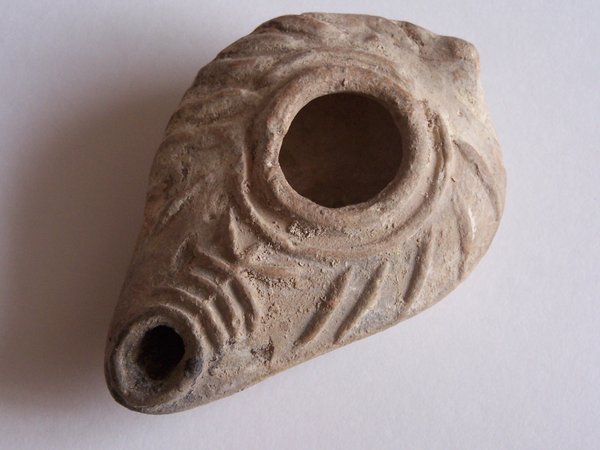
BYZANTINE
Christian / Jewish Era
324 - 640 C.E.
Development of Rabbinical Sermonic Liturgy
Catalogue # 4101, Item # 13:
Samaritan Type
Double Nozzle Rectangular Shaped, Heavy Carbon Deposits over Nozzles,
Decorated with Linear Designs, Rectangular Raised Base,
Probably a sealed plain filling-hole, Very fragile.
5.0 cm W x 9.5 cm L x 3.3 cm H
Excavated in Samaria, North of Jerusalem
Acquired June 1998, Jerusalem
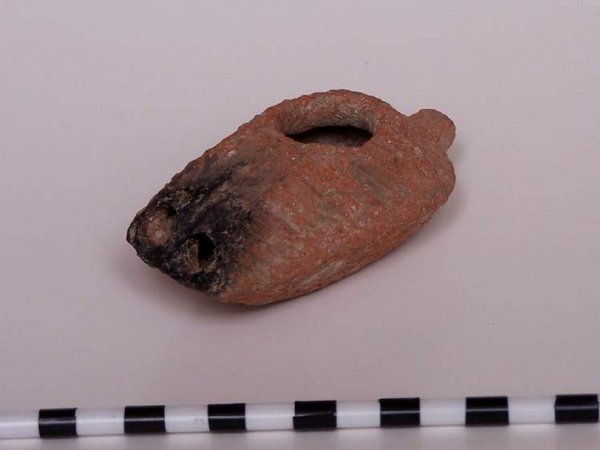
APPENDICES
Glossary of Terms
Characteristics Chart
Excavation Schematic
Bibliography
GLOSSARY OF TERMS:
Absolute Dating – is the determination of the actual age of an object or artefact.
Amorites – one of the peoples found in northern Syria and Mesopotamia from about 3000 B.C.E. who also inhabited the land of Canaan.
Anatolia – the peninsula of Asia Minor, a physical and cultural bridge linking Asia and Europe (Turkey).
Antiquity – the distant past, ancient times; usually the classical Greek and Roman period and everything prior to that time.
Archaeology – study of past, ancient cultures primarily through the study of material cultures (sites and artefacts).
Artefact – an object that has been made or modified by human activity.
Bronze Age – part of the Three Age System, developed by Christian Jurgensen (1788-1865), 'Stone Age, Bronze Age, and Iron Age'.
Burnish – a smooth glossy appearance obtained by rubbing.
Byzantine – a term that reflects a shift in the Biblical Lands from dominance by the Roman Empire to influences from Constantinople and the East; 324-640 C.E.
Canaan; Canaanites – a name found in the Bible in the table of nations (Gen. 10:6) as well as in the cuneiform, Egyptian and Phoenician texts. Land area of Palestine and Jordan.
Chalcolithic – the copper/stone age, 4500-3300 B.C.E.
Chronology – a study of the relationship of materials in a time sequence; the sequence of layers.
Culture- the way of life or sum total of the behaviour and beliefs shared by a particular group.
Excavation – the systematic investigation of an archaeological dig site.
Ghassul; Ghassulian – Chalcolithican culture in Palestine based on a site occupying some 7 acres in the Jordan Valley called Tuleilat Ghassul.
Iron Age – archaeological period span, 1200-332 B.C.E.
Levant – the region of the Eastern Mediterranean, usually Syria, Lebanon, Israel and Jordan.
Lithic – stone materials, used often as a general term for stone tools and weapons.
Mesopotamia – "the land between the rivers" Greek, for the area between the Tigris and Euphrates (Iraq).
Midrash – the investigation, interpretation and study of the Biblical text.
Middle East – the region of the Eastern Mediterranean, usually Syria, Lebanon, Israel and Jordan.
Megiddo – one of the most important Canaanite cities, first mentioned in the annals of Tuthmosis III, 1468 B.C.E.
Near East - the region of the Eastern Mediterranean, usually Syria, Lebanon, Israel and Jordan.
Neolithic – new (later) Stone Age 8500-4500 B.C.E.
Palestine – the region of the Eastern Mediterranean, usually Syria, Lebanon,
Israel and Jordan.
Relative Dating – archaeological method of dating artefacts using a series of techniques that compares artefacts to determine which is older.
Sherds – pottery fragments.
Talmud – Hebrew, the study or teaching of the Torah consisting of the Mishna (Jewish code law) & Gemara (elaboration, commentary of the Mishna).
Tel: Tell – a ruin or mound; an accumulation of layers of human deposits.
Typology – a classification of objects into groups or types according to similar traits; the study of types through time to establish chronology.
Oil Lamp Dating Analysis
Introduction:
Pottery was invented more than 10,000 years ago and is one of the most common categories of finds on archaeological sites, because it was a relatively cheap, everyday commodity and is a material that preserves well in most conditions. On most sites there are usually plenty of fragments (sherds) that can be spared for destructive analysis, which will be outlined below.
The development of the bowl shaped pottery type oil lamp has been dated to the Chalcolithic Period, 4500-300 BCE. and was probably used for a drinking cup, serving bowl or storage vessel as well as a lamp. The style, size and shape continued to evolve with distinctive characteristics which have allowed the archaeologist to accurately date this artefact.
The Dating Methods:
Much information can be gained about pottery just by the examination with the naked eye. Surface details, outside and in, and the cross-section of the vessel can indicate the degree to which the clay was worked, and the nature, size and quantity of temper added. They may also reveal the techniques used in the manufacture and decoration, whether the item's surface was wet-smoothed (self-slipped) or coated in a slip or glaze, and something about the firing conditions. However, the simple stratigraphic principle that older materials will be found lower in an archaeological deposit than newer materials – the law of superposition, allows the archaeologist to categorize the vessel and thus to generally date the item (Relative Dating).
The sources of clay used for ceramics may also be determined by assessing their chemical composition using atomic absorption spectrometry, electron probe microanalysis, neutron activation analysis or other scientific techniques. Details of the firing conditions of pottery, particularly temperature, can be established by a technique known as Mossbauer spectroscopy and by the various thermal analyses. By observing how much weight is lost when the pottery is reheated, the firing temperature can be determined. The same information can be recovered by observing the temperature at which shrinkage of the pottery begins (Absolute Dating).
Bibliography
Ackerman A., Braunstein S., 1982. ISRAEL IN ANTIQUITY, The Jewish Museum
Aharoni Y., 1968. BIBLE ATLAS, The Israel Map and Publishing Co.
Altshuler D., 1983. THE PRECIOUS LEGACY, Smithsonian Institute
Asheri M., 1983. LIVING JEWISH, Everest House
Babylonian Talmud - Various quotes as outlined
Ben-Tor A., 1992. ARCHAEOLOGY OF ANCIENT ISRAEL, The Open University of Israel
Berman Nancy M., 1996. THE ART OF HANUKKAH, Hough Lauter Levin Associates
Birnbaum P., 1991. ENCYCLOPAEDIA OF JEWISH CONCEPTS, Hebrew Publishing Company
Bohm L. Rabbi, 1990. HOLIDAY STUDY GUIDE,
Bridger D., 1976. THE NEW JEWISH ENCYCLOPAEDIA, Behrman House
Browning I., 1980. PETRA, Chatto and Windus
Burland C., Nicholson I., Osborne H., 1970. MYTHOLOGY OF THE AMERICAS, Hamyln Press
Cohen/Mendes-Flohr, 1988. CONTEMPORARY JEWISH RELIGIOUS THOUGHTS, 1st Free Press
Cohn-Sherbok L., 1997. A HISTORY OF THE JEWISH CIVILIZATION, Chartwell Books
Compton's, 1994. ENCYCLOPAEDIA, CD Rom
Diamont M. I., 1962. JEWS, GOD AND THE HISTORY, Signet books
Djuric S., 1995. ANCIENT LAMPS FROM THE MEDITERRANEAN,
Eika/Bookselling/Publishing
Durant A., Durant W., 1994. THE STORY OF CIVILIZATION, World Library inc.
Ebban A., 1978. HISTORY OF THE JEWS - MY PEOPLE, Behrman House
Fagan B. M., 1996. OXFORD COMPANION TO ARCHAEOLOGY, Oxford Press
Gilbert M., 1998. ISRAEL A HISTORY, Doubleday and Company
Goldin J., 1957. THE LIVING TALMUD, First Meridian Printing
Bibliography
Gottlieb F., 1996. THE LAMP OF GOD, First Jason Aronson Incorporated
Grant M., 1996. THE HISTORY OF ANCIENT ISRAEL, Weidenfeld and Nicholson
Hammond N., 1994. WONDERS OF THE ANCIENT WORLD, National Geographic
Hayes J. W., 1980. ANCIENT LAMPS IN THE ROYAL ONTARIO MUSEUM, ROM Pub.
Howard B.P. Dr., 1995. MUSEUM ARTIFACT REASERCH AND REPLICATION SERVICE
Ingpen R., Wilkinson P., 1990. ENCYCLOPEDIA OF MYSTERIOUS PLACES, Prospero Books
Israeli Y., Avida U., 1988. OIL-LAMPS FROM ERETZ ISRAEL, The Israel Museum
Johnson P., 1987. A HISTORY OF THE JEWS, Weidenfeld and Nicholson
Kamm A., 1999. THE ISRAELITES AN INTRODUCTION, Routledge
Keller W., 1982. THE BIBLE AS HISTORY, Bantam Books
Knobel P. S., 1983. GATES OF THE SEASON, Central Conference of American Rabbi
Korn I., 1996. A CELEBRATION OF JUDAISM IN ART, Todtre Productions Ltd.
Negev A., 1990. ARCHAEOLOGICAL ENCYCLOPEDIA OF THE HOLY LAND, Prentice Hall
Mazar A., 1992. ARCHAEOLOGY OF THE LAND OF THE BIBLE, 10,000-586 BCE, Doubleday
McIntosh J., 1999. THE PRACTICAL ARCHAEOLOGIST, Checkmark Books 2nd Edition
Mishna, - Various quotes as outlined
Microsoft, 1994. ENCARTA ENCYCLOPEDIA, CD Rom
Microsoft, 1999. ENCARTA ENCYCLOPEDIA, CD Rom
Meyers E., 1997. OXFORD ENCYCLOPEDIA OF ARCHAEOLOGY IN THE NEAR EAST,
Orlinsky H. M., 1960. ANCIENT ISRAEL, Cornell University Press
Playne Books, 1997. TIME CHART HISTORY OF THE WORLD, Third Millennium Press
Plaut G. W., 1981. The TORAH – A MODERN COMMENTARY, U.A.H.C. Publishing
Porter E., 1980. THE GREEK WORLD, E.P. Dutton Publishing
Bibliography
Potok C., 1978. WANDERINGS, HISTORY OF THE JEWS, Ballantine Books
Ran N., 1987. JOURNEYS TO THE PROMISED LAND, Terra Sancta Arts
Rattey B. K., 1964. A SHORT HISTORY OF THE HEBREWS, Oxford Press
Runes D., 1959. DICTIONARY OF JUDAISM, Citadel Press
Roth C., 1996. ENCYCLOPEDIA JUDAICA, Keter Publishing
Ryan W., Pitman W., 1998. NOHA'S FLOOD, Simon and Schuster
Scheindlin R. P., 1996. THE CHRONICLES OF THE JEWISH PEOPLE, Michael Friedman Pub.
Stefoff R., 1997. FINDING THE LOST CITIES, Oxford Press
Sussman V., 1972. ORNAMENTED JEWISH OIL-LAMPS, Israel Inst. and Exploration Society
The Grolier, 1994. ENCYCLOPAEDIA, CD Rom
The TANAKH, 1985 THE HOLY SCRIPTURES, Jewish Publication Society
Uris L., 1998. JERUSALEM, Doubleday and Company
Von Soden W., 1994. THE ANCIENT ORIENT, William B.Eerdman Publishing


Home | About This Site | Privacy Statement | Gallery | Testimonials | Guarantees
About Collectors' Resources pages | What's New
Search | Site Map | Contact Us